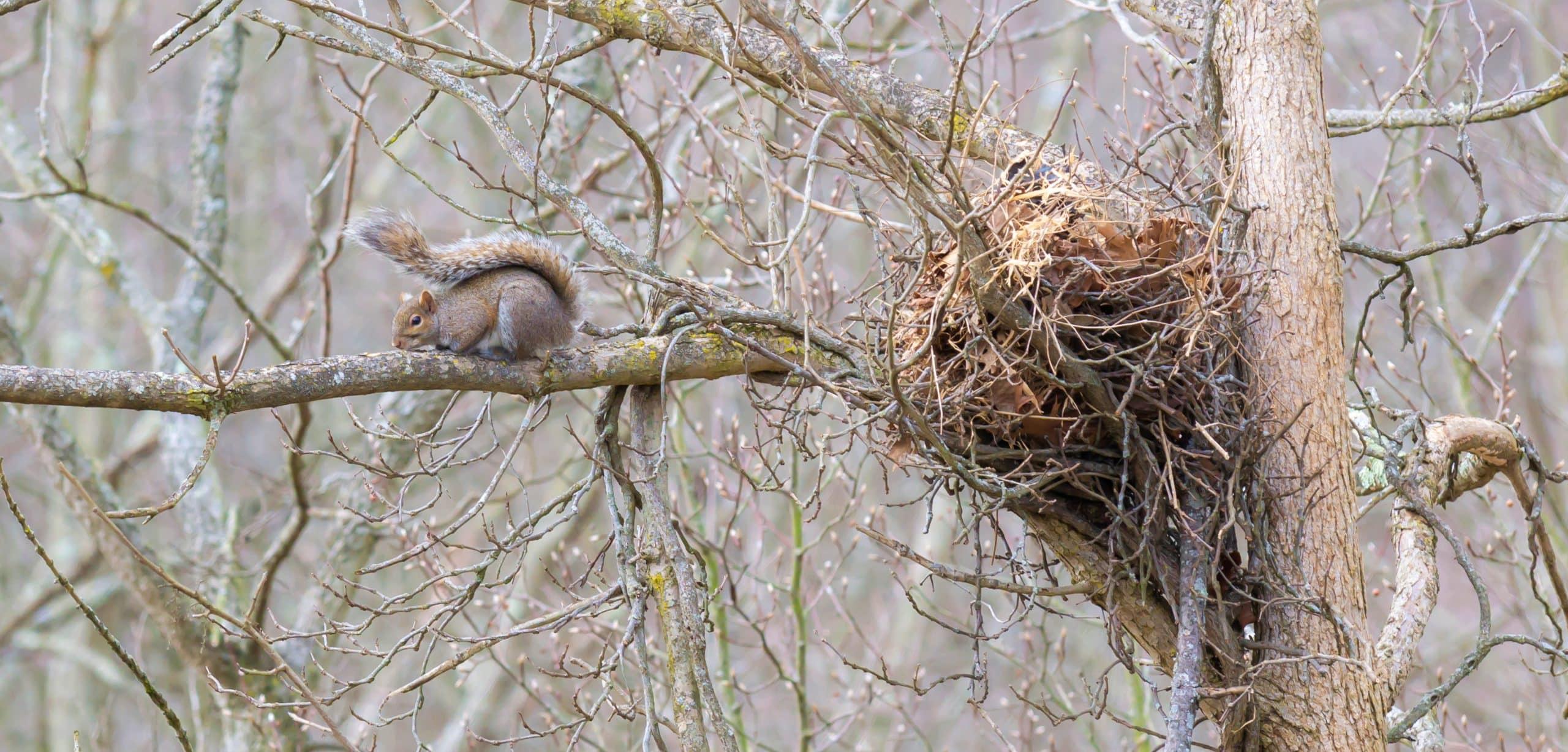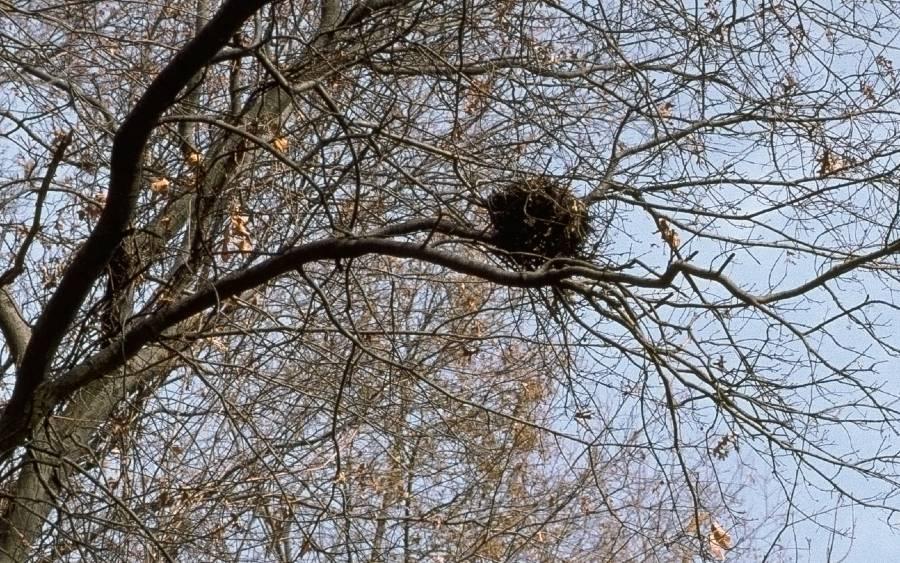To destroy a squirrel nest in a tree, remove any branches or foliage that provide easy access or shelter to the nest.

Credit: quick-catch.com
Signs Of A Squirrel Nest In A Tree
Squirrels can cause damage and inconvenience when they build nests in trees near your home. Identifying these nests is crucial to addressing the problem effectively. One telltale sign is the chattering and scampering sounds created by squirrels as they move around their nests.
Another indicator is the presence of chewing and gnawing marks on the tree bark, resulting from the squirrels’ constant need to file down their teeth. These marks can be seen at the entrance of the nest and on nearby branches.
Additionally, noticing nesting materials such as leaves, twigs, and moss in the branches of the tree is another clue that a squirrel nest may be present. These materials are used by squirrels to create warm and secure dens.
Locating Squirrel Nests In Trees
Observing squirrel behavior and movement, examining tree branches and foliage, and using binoculars to scan tree canopies are effective ways to locate squirrel nests in trees. Squirrels are agile climbers and tend to build their nests high up in tree branches. They prefer dense foliage and trees with sturdy trunks for nesting.
When observing squirrel behavior, look for signs of repeated movement to and from a specific tree. Squirrels are territorial and usually build multiple nests, so observation will help you identify potential nest locations. Examine tree branches for signs of chewed bark or twigs, which can indicate nest construction.
By using binoculars, carefully scan the tree canopies for nests resembling large, round balls made of twigs and leaves. Remember to approach the tree quietly to avoid startling the squirrels. Once you have located the nest, you can proceed with appropriate methods to destroy it.
Potential Damages Caused By Squirrel Nests
Potential damages caused by squirrel nests include structural damage to trees, increased risk of falling branches, and the spread of diseases and parasites. Squirrel nests can weaken the structural integrity of trees, as they chew through branches and create openings for water to enter, leading to decay and rot.
This can increase the risk of branches falling and causing damage to property or injury to people below. Moreover, squirrel nests can harbor diseases and parasites, such as ticks and fleas, that can quickly spread to other wildlife or even pets. It is important to address squirrel nests promptly to prevent further damage and mitigate health risks. If you notice a squirrel nest in a tree, consider seeking professional assistance to safely remove it and prevent recurrence.
Negative Effects On Nearby Buildings And Infrastructure
Roof damage from squirrel access can be a significant negative effect on nearby buildings and infrastructure. Squirrels are skilled climbers and can easily gain access to roofs, leading to potential damage. They may chew through shingles or create holes, allowing water to enter the building and cause leaks. This can result in costly repairs and structural issues if left unaddressed.
In addition to roof damage, squirrels also pose electrical hazards. They have a tendency to chew on wires, which can lead to exposed live wires and potential electrical fires. This poses a risk not only to the building but also to the safety of its occupants.
Furthermore, squirrel nests can lead to contamination from feces and urine. These droppings can carry bacteria and parasites that can pose health risks to humans. Inhaling the airborne particles from the droppings can lead to respiratory issues, especially for those with pre-existing conditions.
It is essential to address squirrel nest removal in trees promptly to mitigate these negative effects on nearby buildings and infrastructure. Seeking professional assistance is recommended to ensure safe and efficient removal.
How to Destroy Squirrel Nest in a Tree : Step by Step Guide
Natural Deterrents And Prevention
Trimming tree branches near structures: One natural way to prevent squirrels from building nests in trees is to trim the branches that are close to structures such as your house or shed. Squirrels often use these branches as launch pads to access your property, so trimming them will make it harder for them to reach potential nesting spots.
Applying squirrel repellents: Another effective method is to use squirrel repellents. These repellents are often made with natural ingredients that squirrels find unpleasant, such as peppermint or hot pepper. By spraying these repellents on the tree branches or areas where squirrels are likely to build nests, you can deter them from nesting in your trees.
Installing squirrel-proof barriers: If trimming branches and using repellents are not enough, you can consider installing squirrel-proof barriers. These barriers can be in the form of metal collars that you wrap around the tree trunk, or specialized devices that prevent squirrels from climbing up the tree. Installing these barriers will physically block squirrels from accessing the tree and building nests.
Non-Lethal Capture And Removal Techniques
Live traps can be an effective and non-lethal way to capture squirrels that have built nests in trees. Once captured, it’s important to relocate the squirrels to a safe area where they won’t cause further damage. Look for a quiet and secluded spot, away from residential areas, and release the squirrels there.
To prevent future nests, it’s crucial to seal off any access points that squirrels can use to climb back into the tree. Use materials such as mesh wire or metal flashing to cover holes or gaps in the tree trunk. This will ensure that squirrels cannot return to build new nests. By following these humane and effective techniques, you can successfully destroy squirrel nests without causing harm to the animals.
Professional Removal Services And Expert Advice
Hiring licensed wildlife control specialists is crucial when it comes to removing squirrel nests from trees. These professionals have the necessary knowledge and experience to handle the situation safely and effectively. They follow regulations set by local wildlife agencies, ensuring ethical considerations are met.
Seeking guidance from local wildlife agencies can provide valuable insights into dealing with squirrel nests. These agencies have a wealth of information on the subject, including tips and techniques for removing nests without causing harm to the squirrels or the environment.
Understanding regulations and ethical considerations is essential to ensure that the nest removal process is carried out responsibly. Wildlife agencies can provide clarity on legal requirements and help you navigate any potential challenges that may arise during the removal process.
Frequently Asked Questions Of How To Destroy Squirrel Nest In A Tree
What Happens If You Disturb A Squirrel Nest?
Disturbing a squirrel nest can cause stress to the squirrels and may lead them to abandon the nest.
What Destroys Squirrel Nests?
Natural predators and human interference can destroy squirrel nests, causing them to abandon or rebuild their homes.
Will A Squirrel Nest Harm A Tree?
Yes, a squirrel nest can harm a tree by causing branch damage and potential tree instability.
How Do You Deal With A Squirrel Nest?
To deal with a squirrel nest, remove any food sources, seal entry points, and use deterrents like noise or lights.
Conclusion
Getting rid of a squirrel nest in a tree requires patience, persistence, and a careful approach. By implementing strategies such as trimming branches, securing access points, and using deterrents like squirrel repellents, you can effectively eliminate the nest and discourage squirrels from returning.
It’s important to prioritize safety throughout the process, whether by using protective gear or seeking professional assistance if needed. Remember to check local regulations and ethical considerations before taking any action. By taking these steps, you not only protect your property but also promote the balance between humans and wildlife in your surroundings.
Be mindful that disrupting a squirrel nest is a last resort, and exploring alternatives that allow coexistence is always encouraged. Take action today, and reclaim your tree from unwanted squirrel nest invasions. Your efforts will surely be rewarded with a tranquil and squirrel-free environment.

